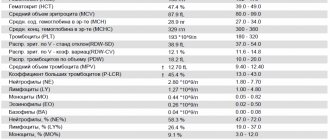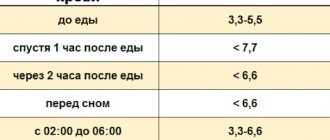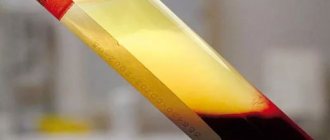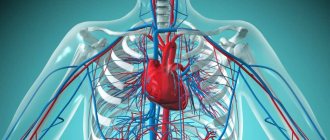Embryology
During fetal development, the single heart tube gives rise to the primary atrium and sinus vein. By the fourth week of pregnancy, the three main paired systems of the embryo - the cardinal, umbilical and ventricular - merge into the sinus venosis. During the fourth week, intussusception occurs between its left flow and the left atrium, eventually separating them. When the transverse segment of the sinus vein moves to the right, it pulls leftward flow along the posterior ventricular groove. The cardiac veins and coronary sinus are formed.
Blood supply to the heart
The blood supply to the heart is carried out by two arteries: the right coronary artery, a. coronaria dextra, and the left coronary artery, a. coronaria sinistra, which are the first branches of the aorta. Each of the coronary arteries emerges from the corresponding right and left aortic sinuses.
- Right coronary artery, a. coronaria dextra, originates from the aorta at the level of the right sinus, follows down the wall of the aorta between the conus arteriosus of the right ventricle and the right appendage into the coronary sulcus; being covered here, in its initial sections, by the right ear, the artery reaches the right edge of the heart and gives off the so-called branch of the right edge to the wall of the ventricle. Having further given a series of branches to the wall of the aorta, appendage and conus arteriosus, the right coronary artery passes to the diaphragmatic surface of the heart, where it also lies in the depths of the coronary sulcus. Here it sends branches to the posterior wall of the right atrium and right ventricle, as well as thin branches accompanying the atrioventricular bundle. On the diaphragmatic surface it reaches the posterior interventricular groove of the heart, in which it descends in the form of the posterior interventricular branch, ramus interventricularis posterior. The latter, approximately at the border of the middle and lower third of this groove, plunges into the thickness of the myocardium. It supplies the posterior part of the interventricular septum and the posterior walls of both the right and left ventricles.
- Left coronary artery, a. coronaria sinistra, larger than the right one; starting at the level of the left aortic sinus, it follows to the left behind the root of the pulmonary trunk, and then between it and the left ear. Heading to the left part of the coronary sulcus, still behind the pulmonary trunk it is most often divided into two branches: the anterior interventricular branch, interventricularis anterior, and the circumflex branch, circumflexus.
At the point where the main trunk passes into the interventricular groove, a large branch branches off from it, passing along the coronary groove to the left half of the heart and feeding the posterior walls of the left atrium and left ventricle with its branches. .
The anterior interventricular branch, interventricularis anterior, is a continuation of the main trunk and descends along the anterior interventricular groove to the apex of the heart, rounding which it enters the terminal section of the posterior interventricular groove; not reaching the posterior interventricular branch, interventricularis posterior, it plunges into the thickness of the myocardium. Along the way, it sends branches to the arterial cone, to nearby sections of the walls of the left and right ventricles, a larger branch to the anterior part of the interventricular septum, anastomotic branches to the stems from the right coronary artery and completely supplies the apex of the heart. Near its origin, the anterior interventricular branch gives off the so-called diagonal artery, which sometimes begins from the main trunk of the left coronary artery. In both cases, it branches in the region of the anterior wall of the left ventricle. The circumflex branch, g. circumflexus, emerging from under the left ear, follows the coronary groove to the left edge of the heart and then along the back of the coronary groove to the diaphragmatic surface of the heart, upon transition to which it sends a large branch that feeds the anterior and posterior walls of the left ventricle. Before reaching the posterior interventricular groove, it descends along the diaphragmatic surface of the left ventricle, but does not reach the apex of the heart. On its way, it sends branches to the walls of the left ear, left atrium and left ventricle. Thus, the right coronary artery supplies the walls of the pulmonary trunk, aorta, right and left atria, right ventricle, posterior wall of the left ventricle, interatrial and interventricular septa. The left coronary artery supplies the walls of the pulmonary trunk, aorta, right and left atria, the anterior walls of the right and left ventricles, the posterior wall of the left ventricle, the interatrial and interventricular septa. The coronary arteries of the heart anastomose with each other in all its parts, with the exception of the edges of the heart, which are supplied only by the corresponding arteries. In addition, there are extracoronary anastomoses formed by vessels supplying the wall of the pulmonary trunk, aorta and vena cava, as well as vessels of the posterior wall of the atria. All these vessels anastomose with the arteries of the bronchi, diaphragm and pericardium. In addition to intercoronary anastomoses (intercoronary), anastomoses of branches of the same artery (intracoronary) are very well developed in the heart. The arteries of the heart, especially in the area of the ventricles, follow the course of the muscle bundles. Thus, in the region of the outer and deep layers of the myocardium, as well as the papillary muscles, the arteries are directed along the longitudinal axis of the heart, and in the middle layer of the myocardium they have a transverse direction.
Most of the veins of the heart (except for the small and anterior) bring blood to a special reservoir - the coronary sinus, sinus coronarius, which opens into the posterior part of the cavity of the right atrium, between the opening of the inferior vena cava and the right atrioventricular opening.
- The coronary sinus, sinus coronarius, seems to be a continuation of its great vein onto the diaphragmatic surface of the heart (see below). It is located in the left part of the posterior coronary sulcus, extending from the place where the oblique vein of the left atrium flows into it from above to its mouth; its length is 2-3 cm. Above the coronary sinus, a thin layer of muscle bundles of the myocardium is thrown, due to which its middle shell, tunica media, is also formed.
- Great vein of the heart, v. cordis magna, begins on the anterior surface of the apex of the heart. First, it lies in the anterior interventricular groove next to the descending branch of the left coronary artery. Having reached the top of the coronary groove, it is located in it and runs along the lower border of the left atrium to the left edge of the heart.
- Oblique vein of the left atrium, v. obliaua atrii sinisiri, begins on the lateral wall of the left atrium and goes from left to right down, in the form of a small branch in the fold
- Posterior vein of the left ventricle, v. posterior ventriculi sinistri, originates on the posterolateral wall of the left ventricle, goes upward and flows either into the great vein of the heart or directly into the coronary sinus.
- Middle vein of the heart, v. cordis media, begins on the posterior surface at the apex of the heart, lies in the posterior longitudinal groove next to the interventricular branch of the right coronary artery and flows into the right end of the coronary sinus. Along the way, the middle vein of the heart receives branches from the posterior walls of both ventricles.
- Small vein of the heart, v. cordis parva, begins on the right edge of the right atrium and right ventricle, lies in the posterior part of the coronary sulcus and flows either into the right end of the coronary sinus, or independently opens into the cavity of the right atrium, sometimes into the middle vein of the heart.
- Anterior veins of the heart
- The smallest veins of the heart, vv. cordis minimae, a group of small veins that collect blood from various parts of the heart and open with the openings of the smallest veins, foramina venarum minimarum. directly into the right and partly into the left atrium, as well as into the ventricles.
The opening of the coronary sinus in the cavity of the right atrium is bordered by the valve of the coronary sinus, valvula sinus coronarii. There are two or three small valves in the sinus itself, not far from its opening.
Having rounded the left edge of the heart, the large vein lies in the diaphragmatic part of the coronary sulcus, where it passes without a sharp border into the coronary sinus. Sometimes there is a small valve at the junction of the great cardiac vein and the coronary sinus. The veins of the anterior wall of both ventricles, the interventricular septum and sometimes near the sinus flow into the large vein of the heart - the posterior vein of the left ventricle.
pericardium. Heading down and to the right along the posterior wall of the left atrium, it passes into the coronary sinus. At the mouth of this vein there is sometimes a small valve.
In the area of the cardiac notch, the middle cardiac vein anastomoses with the great cardiac vein.
,vv. cordis anteriores, have different sizes. They originate in the region of the anterior and lateral walls of the right ventricle, go upward and to the right to the coronary sulcus and flow directly into the right atrium; at the mouths of the anterior veins there are sometimes small valves.
Meaning
There are two separate functions. First, it provides a route for myocardial drainage. Secondly, it offers an alternative way of feeding it. The role of the coronary sinuses is to collect venous blood from the cardiac cavities. The coronary sinus collects 60-70% of cardiac blood. It is of great interest in cardiac surgery and is used for:
- retrograde pacing;
- with extra-telecirculation;
- radiofrequency ablation of ear tachycordia;
- creation of a prosthesis in mitral valve surgery.
Benefit
With the development of new interventional treatments, the coronary sinus has become an important structure. Its benefits are as follows:
- within the tribal branches, electrocatheter stimulators are introduced to stimulate the left ventricles;
- diagnostic conductors are placed in it for recording electrical potentials during endocavitary electrophysiological research;
- trans-catheter ablations of left ventricular tachycardias can be performed in the tributary branches;
- it performs ablation of auxiliary beams;
- it may contain conductors for stimulation of the left atrium, useful for the prevention of atrial fibrillation;
- it is an anatomical finding for puncture of the interventricular septum.
Features of blood flow in the coronary sinus
Back to program
Petrovskaya L.P., Bockeria O.L.
FSBI "NNPCSSKh im.
A.N. Bakulev" of the Ministry of Health of Russia; Introduction. The coronary sinus has been in the spotlight for a long time. Back in 1947, V.A. Valdman emphasized: “The role of the venous system in both physiology and pathology is no less than the arterial one. She was neglected without reason.” The first descriptions of the anatomy of the cardiac veins were made by Raymond Viessin in 1706. and Adam Tebezius in 1708. The coronary sinus (CS) is located in the atrioventricular groove closer to the atrium and is a continuation of the great vein of the heart; its origin is considered to be the confluence of the oblique vein of the heart (the length of the CS is from 20 to 65 mm, the diameter is from 6 to 16 mm), and the posterior, middle and small veins of the heart also flow into it. In pathological conditions of the cardiovascular system, the venous bed, like the arterial bed, undergoes a number of morphofunctional changes. A study conducted in 2003 to assess the topographic and anatomical features of the coronary sinus on 350 hearts of deceased individuals in normal conditions and with cardiac pathology, proved the influence on the anatomical structure of the coronary sinus not only of cardiac pathology, but also of human anthropometric parameters. In 2010, a clinical and anatomical analysis of the intravital state of the VS and venous vessels of the heart was carried out using MSCT, which also proved changes in CS in patients with chronic heart failure (CHF). Every year, works are published around the world on the study of coronary reserve in vivo using transesophageal and transthoracic ultrasound in patients with coronary heart disease, which show a decrease in blood flow in the coronary artery before revascularization. Atrial fibrillation (AF), along with coronary atherosclerosis, occupies an equally important place in the development of cardiac complications. During AF, diastole shortens due to tachycardia, lack of coordinated atrial systole and irregular ventricular excitation. All this leads to hemodynamic disturbances, venous stagnation, a decrease in the speed of blood flow in the heart muscle, death of cardiomyocytes and the development of CHF. In recent years, data on the volumetric velocity of blood flow in the coronary sinus in healthy people began to appear in foreign literature using methods such as continuous thermodilution and phase-contrast MRI. Thanks to the MR image analysis program - 4D Flow, in a relatively short period of scanning time, it is possible to study and calculate various blood flow parameters, obtaining color speed mapping of the directions and distributions of flows, blood flow vectors in natural conditions. Currently, there is no data in the world on studying blood flow in the coronary sinus using the 4D Flow program, which determines the uniqueness and relevance of our planned study. Conclusions. It is necessary to identify changes in volumetric and linear blood flow velocity in the coronary sinus in patients with AF, identified by MRI data using the 4D Flow program, and evaluate the prognostic value of these indicators for the development of chronic heart failure.
Defects
Within the considerable body of information surrounding congenital heart disease, anomalies related to the coronary sinus have received relatively little attention. Although some of them can be of great importance. They can be isolated and harmless, but can also be a component of various serious malformations. Failure to recognize such defects can lead to serious problems during surgery.
The most common anomaly is enlargement of the coronary sinus. It can be divided into two broad groups based on the presence or absence of a shunt in the heart.
The next anomaly is the absence of the coronary sinus. It is always associated with permanent connection of the left superior vena cava with the left atrium, atrial septal defect and other additional disorders. Typically has a right to left shunt at the level of the right atrium as part of a complex functional abnormality.
Another defect is atresia or stenosis of the right coronary sinus. In this case, the abnormal venous channels serve as the only route or main collateral outflow of blood.
Sinuses of the brain - possible pathologies, treatment
The human brain works around the clock, so it requires a large amount of energy. Its reliable operation is guaranteed by numerous sinuses of the brain. Outflow, which is provided by the vessels of the main organ: venous, multi-tiered plexuses, arteries and capillaries.
General information
The vascular part makes up almost half the area of the volume of the cerebral bed. This is a complex consisting of numerous anastomotic tissues arranged in layers.
The main difference between the venous system and the arterial system is that the venous part has a much larger reservoir.
Sinus anatomy looks like this.
These parts of the meninges often contain fluid surrounded by endothelium.
Kinds
What are the sinuses of the brain? These are venous collectors that were formed during the natural splitting of the hard shell. They are divided into the following types:
- Inferior sagittal. This is an unpaired organ. It includes the medial surface of the hemispheres. When connected to the great cerebral vein, it smoothly passes into the direct venous collector.
- Superior sagittal. Not paired, runs in the middle of the hemispheres, the side walls have small gaps that connect the gap with the side moons.
- Transverse. Paired, it includes all the veins of the GM.
- Sigmoid. It is also a pair, into which the temporal venous plexus flows.
- Sphenoparietal. Located near the sphenoid bone. The cavernous plexus smoothly passes.
- Sine drain. In other words, this is the place where two are connected at once - the upper and the straight.
- Straight. It's not paired. From the back they connect to the transverse vessels.
- Cavernous. Paired and the most complex in its anatomical structure. It includes the carotid artery.
Without the uninterrupted operation of the entire circulatory system, the organ will not be able to function fully.
Peculiarities
What is a transverse sinus? Without exception, all venous sinuses of the brain are an important element of the entire venous network of this organ.
Knowing exactly all their features, structure and location, doctors can accurately diagnose a particular pathology.
The main features of the cerebral plexuses.
- Triangular shape.
- They are located in the furrow part.
- The shell leaves are strong and tense.
- They do not have valves, which ensures normal blood flow.
- The surface of the periosteum is covered with fibrous cells, and the cavity of the canals from the inside is covered with a thin endothelial layer.
In addition to structural features, the venous network also has functional features. They act as blood reservoirs in the venous sinuses of the dura mater.
Where are they located?
They run along the bottom of the skull. The plexuses are located next to each other. If there is a plexus disorder, the organ works at half its strength.
Upper
The origin of the sinus begins at the crest of the ethmoid bone. It is located exactly in the middle, thereby filling the interhemispheric gap that separates the hemispheres from each other.
Lower
It is located on the lower part of the falx, which is why it has such a characteristic name.
Straight
Located in the location of the tentorium and falx GM, covering the cerebellum. In addition, it has a sagittal direction.
Transverse
It is located on the superficial groove of the same name in the occipital part. The groove of the transverse sinus is the area from which the cerebellar tentorium extends.
Sigmoid
The sigmoid vessels on both sides are occupied by sigmoid grooves, shaped like the letter S.
Cavernous
Located at the base of the skull on the sides of the sella turcica.
Occipital
Located near the falx cerebri and the inner crest of the occipital bone.
Possible pathologies
Most diseases have not yet been fully studied, although they are detected in the early stages thanks to modern diagnostic methods.
| Name of disease / Which collector is affected | Reasons for development | Symptoms or how it manifests itself | Complications |
| Thrombosis/cerebral | Past infectious disorders. Intrauterine fetal hypoxia. Late toxicosis. Systemic diseases of an inflammatory nature. | Seemingly causeless convulsions. Constant nervousness. Headache attacks | Without proper treatment, the prognosis is poor: disability or death |
| Occlusion/sagitral | The main causes are infections that cause severe inflammation. | Weakness in the legs. Severe headaches. Bleeding from the nose | Decreased vision percentage. Ptosis of the eyelids. Decreased production of pituitary hormones |
| Embolism / all GM vessels | Heart diseases. Diabetes. Oncological diseases | Pain syndrome in the chest area. Constant shortness of breath | Pulmonary infarction. Paradoxical embolism. Increased pressure in the human lungs |
| Cerebral atherosclerosis / cerebral | Liver disorders. Excessive smoking and drinking alcohol. Genetic predisposition. Hormonal disorders | Temporary amnesia. Mental disorders. Chronic fatigue | Without treatment, there is a possibility of developing complete amnesia, death, or severe mental impairment of the person. |
| Stenosis / all collectors | Diabetes mellitus increased body weight Smoking genetic predisposition | Emotional instability. Memory loss | Loss of coordination. Uncontrolled urination. Death. It all depends on the stage of the disease. |
GM pathologies are varied. The table above covers only common vascular diseases.
Which doctors treat disorders
A couple of years ago, patients with problems with the circulatory system came to see a surgeon. In most small villages, this situation has not yet changed in any way.
But in big cities, every state hospital sees a phlebologist. And if necessary, the doctor will refer the patient to a vascular surgeon.
Diagnostic methods
Diagnostic measures include the following:
To ensure the correct diagnosis, a histological examination is performed. A fragment taken from the site of the rash for study is separated by biopsy.
It is not possible to carry out a diagnosis at home or without consulting a competent doctor, so there is no need to hesitate and go to the hospital at the first sign.
Treatment
It must be said right away that therapy is difficult and requires a lot of strength and patience. The doctor must know what is in the sinuses of the dura mater.
Treatment of pathologies of the circulatory system is a combination of methods and medications, the goal of which is to defeat the disease or eliminate the manifestation of unwanted symptoms.
The therapy scheme for the dural sinuses is as follows.
| Name of violation | Groups of drugs used | A course of treatment | Result |
| Thrombosis | Warfarin | No more than 7 days | Reduces the level of blood clotting, prevents the risk of blood clot formation |
| Heparin | The course of treatment is 20 days | ||
| Let's thrombus. | The course of therapy is 6 months under strict coagulogram control | Able to destroy the resulting stagnation of blood, normalizes the general condition of a person | |
| Obstruction of the sagittal collector | Ceftriaxone | Dosing and duration of therapy is determined differently for each patient | Helps liquefy and eliminate clots |
| Oxacillin | Just like the previous remedy, the dosage is selected for a certain age. | ||
| Embolism | Urokinase | The duration of administration and dosage are prescribed by the doctor individually | Prevents the formation of blood clots. |
| Heparin | The duration of therapy is 6 months. | ||
| Clexane | The average course of treatment with the drug is 7-10 days | ||
| Cerebral atherosclerosis. | Lovastatin | Duration of therapy 3 months | Improves vascular function |
| Hepalex | |||
| Cavinton | |||
| Stenosis | Drotaverine | The course of treatment and its duration are determined differently. | Relieving spasm |
| Plavix | Dosage and treatment regimen are determined taking into account the primary pathology. |
Only a systematic approach to the prevention of cerebrovascular diseases can ensure a quality life without threat.
Source: //venaprof.ru/sinusy-golovnogo-mozga/
Aneurysm of sinus of Valsava
This pathological dilatation of the aortic root is also called coronary sinus aneurysm. Most often found on the right side. Occurs as a result of weak elasticity of the plate at the junction of the aortic medium. The normal sinus diameter is less than 4.0 cm for men and 3.6 cm for women.
Coronary sinus aneurysm can be either congenital or acquired. The first may be associated with connective tissue diseases. It is connected to the bicuspid aortic valves. The acquired form can occur secondary to chronic changes in atherosclerosis and cystic necrosis. Other causes may include chest trauma, bacterial endocarditis, and tuberculosis.
Sick sinus syndrome
The term was coined in 1962 by American cardiologist Bernard Lown. The diagnosis can be made if at least one of the typical findings on the electrocardiogram has been demonstrated:
- inadequate bradycardia of the coronary sinus;
- freezing of the sinus node;
- sinoatrial block;
- atrial fibrillation;
- atrial flutter;
- supraventricular tachycardia.
The most common cause of sick sinus syndrome is hypertension, which leads to chronic strain on the atrium and then overstretching of the muscle fibers. The key examination method is long-term ECG.
Pathologies
The coronary sinus can be affected by cardiopathy and diseases that impair the functions of the heart. In most cases, these diseases are associated with pathologies of the coronary arteries. The most common of them:
- Abnormal venous return. This rare pathology corresponds to a congenital malformation affecting the coronary sinus. It causes organ dysfunction, which can lead to heart failure.
- Myocardial infarction. Also called a heart attack. It corresponds to the destruction of part of the myocardium. Deprived of oxygen, cells collapse and die. This leads to cardiac dysfunction and cardiac arrest. Myocardial infarction is manifested by rhythm disturbance and failure.
- Angina pectoris. This pathology corresponds to oppressive and deep pain in the chest. Most often this happens during times of stress. The cause of pain is improper supply of oxygen to the myocardium, which is often associated with pathologies affecting the coronary sinus.
Coronary sinus: norm and deviations, functions
The coronary sinus is the largest vein of the heart. It is the least studied compared to its arterial counterpart due to life-saving interventional approaches through the coronary artery. Most modern electrophysiology procedures require an in-depth study of the coronary sinus and its tributaries.
Basic anatomy
This is a wide channel - about 2-5.5 cm long with an opening 5-15 mm in diameter. It contains a fold of endocardium called the valve of Tibesius. It is the caudal part of the right valve of the embryonic sinus opening. Located in the diaphragmatic part of the coronary sulcus.
Physiology
The coronary sinus is formed by the connection of the great cardiac vein and the main posterior lateral vein. The first passes along the interventricular groove similar to the left anterior descending artery.
The other major tributaries entering the coronary sinus are the inferior left ventricular vein and the middle cardiac vein. The atrial myocardium also drains into it through various atrial vessels and veins of Tibesius.
Embryology
During fetal development, the single heart tube gives rise to the primary atrium and sinus vein. By the fourth week of pregnancy, the three main paired systems of the embryo - cardinal, umbilical and ventricular - merge into the sinus venosis.
During the fourth week, intussusception occurs between its left flow and the left atrium, eventually separating them. When the transverse segment of the sinus vein moves to the right, it pulls leftward flow along the posterior ventricular groove.
The cardiac veins and coronary sinus are formed.
There are two separate functions. First, it provides a route for myocardial drainage. Secondly, it offers an alternative way of feeding it. The role of the coronary sinuses is to collect venous blood from the cardiac cavities. The coronary sinus collects 60-70% of cardiac blood. It is of great interest in cardiac surgery and is used for:
- retrograde pacing;
- with extra-telecirculation;
- radiofrequency ablation of ear tachycordia;
- creation of a prosthesis in mitral valve surgery.
Benefit
With the development of new interventional treatments, the coronary sinus has become an important structure. Its benefits are as follows:
- within the tribal branches, electrocatheter stimulators are introduced to stimulate the left ventricles;
- diagnostic conductors are placed in it for recording electrical potentials during endocavitary electrophysiological research;
- trans-catheter ablations of left ventricular tachycardias can be performed in the tributary branches;
- it performs ablation of auxiliary beams;
- it may contain conductors for stimulation of the left atrium, useful for the prevention of atrial fibrillation;
- it is an anatomical finding for puncture of the interventricular septum.
Defects
Within the considerable body of information surrounding congenital heart disease, anomalies related to the coronary sinus have received relatively little attention. Although some of them can be of great importance.
They can be isolated and harmless, but can also be a component of various serious malformations. Failure to recognize such defects can lead to serious problems during surgery.
The most common anomaly is enlargement of the coronary sinus. It can be divided into two broad groups based on the presence or absence of a shunt in the heart.
The next anomaly is the absence of the coronary sinus. It is always associated with permanent connection of the left superior vena cava with the left atrium, atrial septal defect and other additional disorders. Typically has a right to left shunt at the level of the right atrium as part of a complex functional abnormality.
Another defect is atresia or stenosis of the right coronary sinus. In this case, the abnormal venous channels serve as the only route or main collateral outflow of blood.
Aneurysm of sinus of Valsava
This pathological dilatation of the aortic root is also called coronary sinus aneurysm. Most often found on the right side. Occurs as a result of weak elasticity of the plate at the junction of the aortic medium. The normal sinus diameter is less than 4.0 cm for men and 3.6 cm for women.
Coronary sinus aneurysm can be either congenital or acquired. The first may be associated with connective tissue diseases. It is connected to the bicuspid aortic valves. The acquired form can occur secondary to chronic changes in atherosclerosis and cystic necrosis. Other causes may include chest trauma, bacterial endocarditis, and tuberculosis.
Sick sinus syndrome
The term was coined in 1962 by American cardiologist Bernard Lown. The diagnosis can be made if at least one of the typical findings on the electrocardiogram has been demonstrated:
- inadequate bradycardia of the coronary sinus;
- freezing of the sinus node;
- sinoatrial block;
- atrial fibrillation;
- atrial flutter;
- supraventricular tachycardia.
The most common cause of sick sinus syndrome is hypertension, which leads to chronic strain on the atrium and then overstretching of the muscle fibers. The key examination method is long-term ECG.
Pathologies
The coronary sinus can be affected by cardiopathy and diseases that impair the functions of the heart. In most cases, these diseases are associated with pathologies of the coronary arteries. The most common of them:
- Abnormal venous return. This rare pathology corresponds to a congenital malformation affecting the coronary sinus. It causes organ dysfunction, which can lead to heart failure.
- Myocardial infarction. Also called a heart attack. It corresponds to the destruction of part of the myocardium. Deprived of oxygen, cells collapse and die. This leads to cardiac dysfunction and cardiac arrest. Myocardial infarction is manifested by rhythm disturbance and failure.
- Angina pectoris. This pathology corresponds to oppressive and deep pain in the chest. Most often this happens during times of stress. The cause of pain is improper supply of oxygen to the myocardium, which is often associated with pathologies affecting the coronary sinus.
Examination of the coronary sinuses
In order to take timely measures to treat various pathologies of the coronary veins, it is necessary to undergo regular examinations. It takes place in several stages:
- Clinical examination. It is performed to study the rhythm of the coronary sinus and evaluate symptoms such as shortness of breath and rapid heartbeat.
- Medical checkup. Cardiac or Doppler ultrasound may be performed to establish or confirm the diagnosis. They can be supplemented with coronary angiography, CT and MRI.
- Electrocardiogram. This examination allows you to analyze the electrical activity of the organ.
- Electrocardiogram of stress. Allows you to analyze the electrical activity of the heart during physical activity.
Source: //FB.ru/article/460737/koronarnyiy-sinus-norma-i-otkloneniya-funktsii
Examination of the coronary sinuses
In order to take timely measures to treat various pathologies of the coronary veins, it is necessary to undergo regular examinations. It takes place in several stages:
- Clinical examination. It is performed to study the rhythm of the coronary sinus and evaluate symptoms such as shortness of breath and rapid heartbeat.
- Medical checkup. Cardiac or Doppler ultrasound may be performed to establish or confirm the diagnosis. They can be supplemented with coronary angiography, CT and MRI.
- Electrocardiogram. This examination allows you to analyze the electrical activity of the organ.
- Electrocardiogram of stress. Allows you to analyze the electrical activity of the heart during physical activity.










